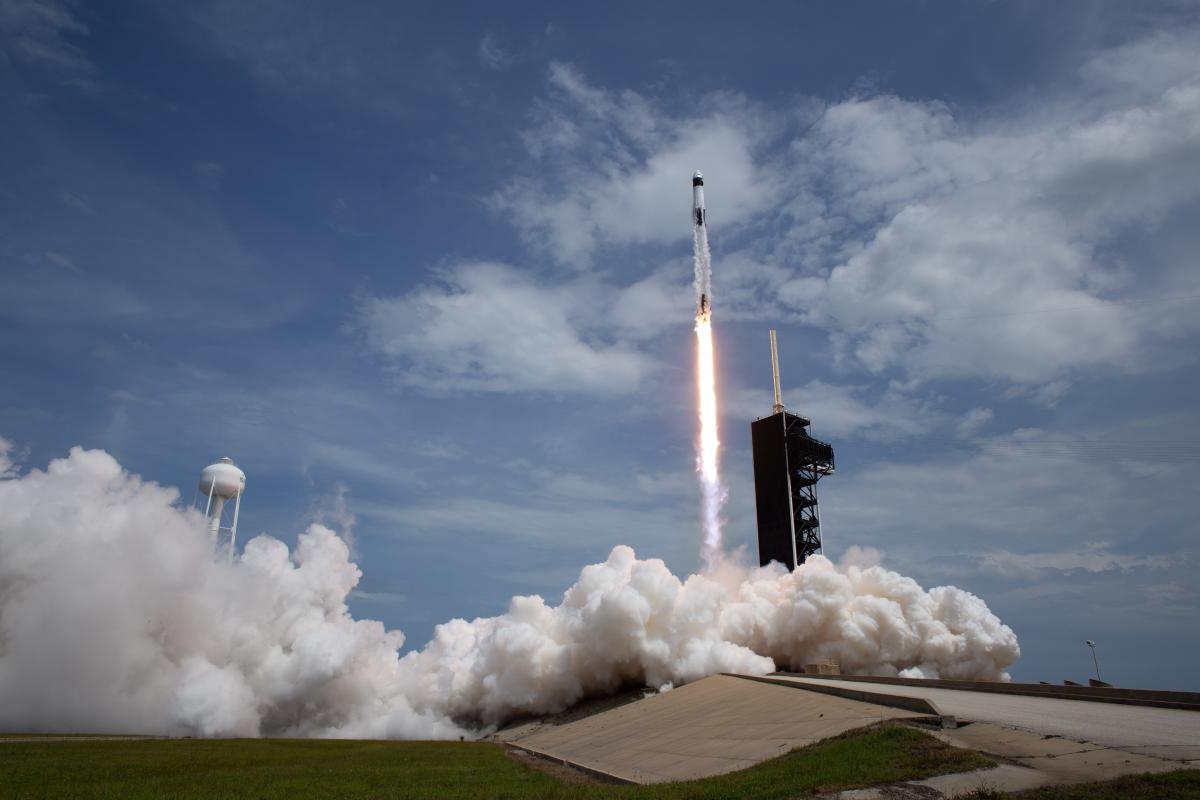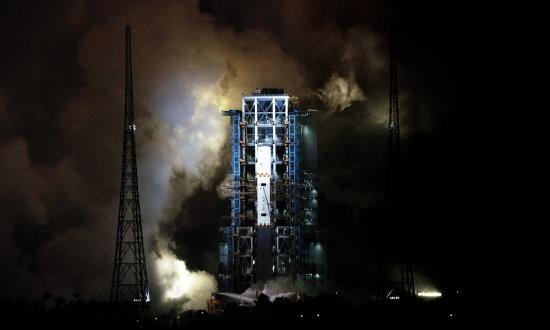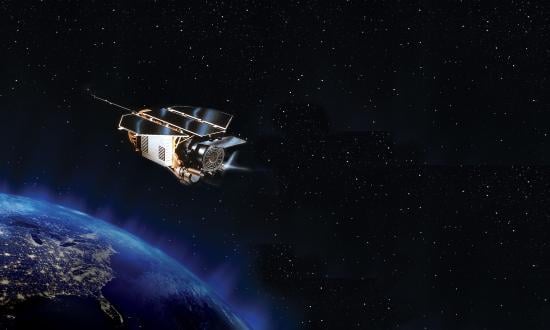In the prelude to any conflict with the United States, China’s People’s Liberation Army (PLA) will target U.S. satellites to degrade the U.S. armed forces’ ability to fight. China has invested heavily in kinetic and nonkinetic offensive counter-space capabilities explicitly focused on destroying space-enabled U.S. command, control, and communications networks. The Sea Services rely on satellite-enabled networks for missions ranging from aerial reconnaissance and GPS navigation to over-the-horizon targeting and ballistic missile defense. These networks in turn rely on expensive high-orbit, high-capability satellites that would be difficult to replace in any sustained conflict with China. PLA strategists hope that by credibly threatening to render U.S. forces deaf, dumb, and blind, they can at a minimum impede the U.S. ability to shoot, move, and communicate, or at best completely deter a U.S. response to Chinese aggression.
The Sea Services must prepare for this contest by taking advantage of three fast-maturing technologies: low-cost reusable commercial space launch; large-scale, low-earth orbit communications constellations (such as SpaceX’s Starlink); and unmanned terrestrial platforms functioning as ad hoc communications networks.
These technologies must be part of a conceptual shift away the assumption of space superiority in support of maritime operations. The Sea Services must embrace communication technologies and operational concepts that build in resilience and allow networks to degrade gracefully in the face of PLA targeting. In isolation, none of these technologies will be a panacea—networks will still be targeted, and the Navy will face progressively more friction as it pushes closer to China’s shores. To credibly deter aggression, the Navy must be able to close kill chains along a variety of interlocking and redundant pathways that give forward naval forces maximum optionality when targeting PLA aggressors.
Deaf, Dumb, and Blind
The PLA no longer considers space an adjunct to the aerial domain; it now regards space as a distinct domain of strategic importance, alongside nuclear and cyber.1 Doctrine and technology for the domain have evolved in tandem as part of the larger PLA force modernization. Having closely studied U.S. operations during the 1991 Gulf War, the PLA is preparing for “informatized war” in which both belligerents will be reliant on robust communications for network-enabled operations. The PLA is moving away from platform-centric force development to doctrine that places a premium on targeting enemy command-and-control networks. The 2013 Science of Military Strategy, an authoritative strategic document published by the PLA Academy of Military Science, explicitly recognizes U.S. reliance on satellite networks and the need to disrupt these networks early in a conflict. It argues that “achieving space superiority . . . [is] critical for achieving overall superiority and being victorious over an enemy.”
Chinese leaders and PLA planners have already laid the groundwork for a justification of preemptive military action under a Maoist doctrine of “active defense.” PLA strategists have argued that a “first shot” on the “plane of politics” (for example, U.S. recognition of Taiwanese independence) would be grounds for a so-called “counterattack” on U.S. forces.2 In their minds, the United States will have been the aggressor by crossing one of the many ever-expanding CCP hegemonic red lines, thus provoking China into what they would perceive as legitimate self-defense. The PLA would move quickly to target U.S. space assets to deter any further action.
The PLA is developing multiple weapons that can destroy and degrade U.S. space networks. Since 2005, China has conducted six publicly known antisatellite (ASAT) tests using direct-ascent ballistic missiles carrying kinetic kill vehicles. The most publicized of these tests was a 2007 shoot-down of an antiquated Chinese FengYun-1 meteorological satellite in low-earth orbit using a modified DF-21 medium-range ballistic missile. The test garnered widespread global condemnation because of the enormous debris field that jeopardized numerous commercial and scientific satellites and persists to this day. China conducted additional tests in 2010, 2013, and 2014, demonstrating expanded capability to reach high-orbit geosynchronous satellites. It is within this higher geosynchronous orbit that many of the most capable ISR, communication, and missile warning satellites reside. The PLA has since moved beyond one-off demonstrations, standing up dedicated military units that train to integrate ASAT attacks into broader joint operations.
All these capabilities reside within what the Defense Intelligence Agency terms a “counterspace continuum” of threats to space-based services. Among the nonkinetic ASAT technologies being developed by the PLA are ground-based lasers and other directed-energy weapons. The National Reconnaissance Office (NRO) confirmed that China conducted a 2006 ground-based laser test targeting a U.S. satellite. The effects of lasers can range from a temporary dazzling of sensors to destruction of entire satellites through more powerful, directed, microwave radiation weapons. Because of their mobility, such systems can be difficult to attribute or counter-target.
Cyber represents another threat to U.S. space-based services. PLA hackers will likely target space networks seeking everything from intelligence gathering to spoofing of GPS signals to network denial and disruption. Civilian mariners have reported increasing numbers of GPS jamming and spoofing incidents in around the South and East China Seas, jeopardizing safe navigation.3
Space Resiliency in Maritime Operations
Space asset survivability has been a long-standing concern. Ever since the dawn of the space age, the United States and Soviet Union have been contesting space. In 1978, Admiral Stansfield Turner, then serving as CIA Director, confirmed the existence of Soviet “killer satellites” designed to down U.S. satellites in the prelude to conflict. PLA counter-space operations could acutely impact the expeditionary operations of the Sea Services. Senior leaders recognize this reality and have made space resiliency a top service priority. In his January 2021 NAVPLAN, Chief of Naval Operations Admiral Michael Gilday directed the service to pursue technologies that will allow the Navy to close kill chains faster than the PLA “with a resilient web of persistent sensors, command and control nodes, platforms, and weapons.” Achieving this goal will require the Sea Services to leverage emerging space technologies.
In a contingency with the PLA, assuring space resilience in maritime operations will depend on several factors. First, the Sea Services must be able to replace damaged or destroyed space assets in a timely and cost-effective manner. Second, they must ensure baseline communication access by having robust network access in key geographic theaters of operation. Finally, carrier strike groups must retain an organic ability to generate ad hoc, over-the-horizon terrestrial networks independent of all space assets.
Replacing attrited satellites will be crucial if Navy and Marine Corps systems are targeted by the PLA. Legacy launch services such as the United Launch Alliance, a joint venture between Boeing and Lockheed Martin, remain the primary providers for national security launches with their workhorse heavy-lift Atlas V and Delta IV rockets. And newer commercial space launch companies are progressively reducing the exorbitant cost of space launch. While SpaceX and Blue Origin are best known, multiple companies—Astra, Rocket Lab, and Virgin Orbit, to name a few—are competing to develop low-cost, reusable launch systems.
Commercial launch development has so far predominantly focused on low-earth orbit launches, crewed spaceflight for space tourism, cost reduction, and reusability. Excepting SpaceX’s Falcon Heavy, none of these new companies has yet developed a capability to reach above low-earth orbit to more operationally significant geosynchronous orbits. However, SpaceX is building a track record of national security launches. Next generation heavy-lift rockets currently in development, such as SpaceX’s Super Heavy booster and Blue Origin’s New Glenn, will be capable of carrying heavier payloads to higher orbits with the cost advantages of reusability. In the long term, commercial space development will provide the Sea Services cost-effective options for replacing high-orbit, high-capability satellites targeted by the PLA.
In the near-term, commercial space development will bring operationally significant advances in flexibility and responsiveness for smaller military payloads in low-earth orbit. The Defense Advanced Research Project Agency’s (DARPA’s) Launch Challenge invites commercial teams to launch payloads on extremely short notice, with no prior knowledge of the payload, destination orbit, or launch site, and do it twice within days—conditions analogous to a fluid military contingency. The Launch Challenge is just the latest in a series of DARPA programs to encourage on-demand, responsive, commercial launch options for military operations.
The Launch Challenge showed promise, with competitor Astra coming within seconds of launch in March 2020. The payload was a Prometheus CubeSat developed by the Los Alamos National Laboratory. Prometheus was designed to support military applications such as over-the-horizon communication but in a manner that could be mass-produced at low cost. Despite being narrowly unsuccessful, the pairing of Prometheus CubeSats with Astra’s on-demand, responsive launch shows enormous potential. DARPA is in discussions to follow the Launch Challenge by integrating responsive satellite launch capability into a major military exercise such as Rim of the Pacific.
While DARPA pursues tailor-made launch solutions for military operations, commercial space companies are launching mega constellations of satellites that provide high-speed, low-latency internet access. At the forefront is SpaceX’s Starlink, a low-earth orbit constellation that will eventually number more than 42,000 small-sats; it is already operational and providing consumer internet access. Amazon’s Project Kuiper and U.K.-based OneWeb are launching rival constellations, as well.
Chinese companies are pursuing similar constellations geared toward regions of the Digital Silk Road, a digital adjunct to the Belt and Road Initiative. Although satellite internet already exists, the density of these networks provides extremely low-latency coverage to previously remote and underserved locations relatively inexpensively. Recognizing the potential of geographically unlimited broadband internet, the Army signed a three-year research agreement with SpaceX to explore how Starlink can meet increasing demand for soldier connectivity in the field. The Army’s experience will show whether Starlink or similar commercial constellations can be of value to forward naval forces in a contested Indo-Pacific region.
Commercial constellations also could serve as key enablers for Admiral Gilday’s goals in Project Overmatch. Announced in October 2020, Project Overmatch directed the Navy to develop networks, infrastructure, and data architecture to sustain maritime dominance and integrate with the joint force’s all-domain command-and-control efforts. The sheer number of satellites in the constellations makes it impractical for the PLA to degrade the network through solely kinetic attacks. Given that these constellations are designed to provide persistent network access to remote locations, they could be a viable off-the-shelf option for the Indo-Pacific and transpacific sea-lanes to Hawaii and the U.S. west coast.
Prudence demands preparation for situations in which the PLA has been successful in denying space services. Carrier strike groups can leverage emerging unmanned systems to generate temporary, ad hoc networks to support localized maritime operations as the ultimate network fail-safe. Since 2015, DARPA has been working with Dynetics to develop air-launched and -recovered drones called Gremlins. Resembling cruise missiles, Gremlin drones can be launched from bombers, cargo aircraft, or even fighters.
The underlying concept envisions manned command aircraft loitering on the edge of contested airspace while Gremlin drones push into high-risk zones. Integrating Gremlins into carrier strike groups would accelerate developing and integrating unmanned systems, something Admiral Gilday has highlighted urgent need to increase the lethality and survivability of naval forces. As an attributable platform, Gremlin drones would provide strike groups and carrier air wings flexibility to operate in contested environments in which PLA electronic attack may preclude access to space-based networks. If launched in sufficient numbers, Gremlins would be nodes in a moveable network providing jam-resistant, secure line-of-sight communications.
After World War II, Congress called on Fleet Admiral William “Bull” Halsey to reflect on the changed character of war. Testifying before the House Armed Services Committee, Halsey argued, “The lesson from the last war that stands out clearly above all the others is that if you want to go anywhere in modern war . . . you must have command of the air.”4 Today, if we want to go anywhere in modern war, we must have command of the heavens. China is investing in PLA counter-space capabilities to deny U.S. forces that command of space. The credibility of U.S. deterrence will depend on the Sea Services’ strength and ability to maintain space resiliency. A war with China will be the Navy’s war, so the Navy must lead not only on the sea and in the air, but also in space.
1. Peng Guangqian and Yao Youzhi, eds., The Science of Military Strategy (Beijing: Military Science Publishing House, 2005).
2. M. Taylor Fravel, Active Defense: China's Military Strategy since 1949 (Princeton, NJ: Princeton University Press, 2019), 63.
3. “Vessels Navigating in China Report GPS Spoofing Incidents.”
4. Charles M. Westenhoff, “Why We Need an Air Force,” (1995), 66.






